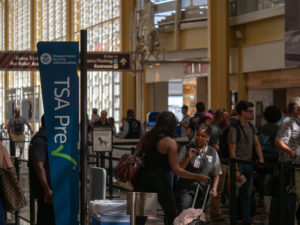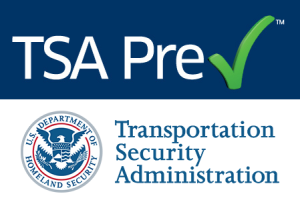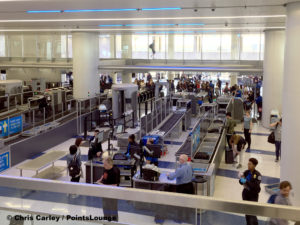Advertiser Disclosure: Eye of the Flyer, a division of Chatterbox Entertainment, Inc., is part of an affiliate sales network and and may earn compensation when a customer clicks on a link, when an application is approved, or when an account is opened. This relationship may impact how and where links appear on this site. This site does not include all financial companies or all available financial offers. Opinions, reviews, analyses & recommendations are the author’s alone, and have not been reviewed, endorsed, or approved by any of these entities. Some links on this page are affiliate or referral links. We may receive a commission or referral bonus for purchases or successful applications made during shopping sessions or signups initiated from clicking those links.
TSA PreCheck is a must for even semi-frequent travelers. But with TSA’s new, high tech CT scanners at nearly 20 major airports, could PreCheck be on the way out? Or at least become much less necessary?
Fellow BoardingArea blogger, The Flight Detective detailed the new 3-D scanners that allow passengers to keep liquids and laptops in carry-ons while going through security.
The agency explains:
TSA’s current screening technology for carry-on bags uses 2-D images.
The CT technology applies sophisticated algorithms for the detection of explosives and other threats by creating a 3-D image that can be viewed and rotated 360 degrees for a thorough analysis.
Like existing CT technology used for checked baggage, the machines create such a clear picture of a bag’s contents that computers can automatically detect explosives, including liquids.
In the future, the goal is to keep laptops and 3-1-1 liquids inside of the bag during checkpoint screening. Under current screening procedures for this technology, laptops are allowed to remain inside the bag for screening.
Leaving laptops and liquids in carry-ons is a major perk of TSA PreCheck. But if we’ll no longer have to remove those items — and, clearly, that day is coming — will PreCheck even be necessary?
What Is the Future of PreCheck?
3-D technology could very well streamline everything and eliminate the need for PreCheck.
I like that, though. Expeditious and quality basic security shouldn’t be limited to a certain group of travelers on the same flights as everyone else. No matter who’s in which line — PreCheck or not — the TSA is famous for failing 95% of the time to find weapons during tests. Hopefully, the new technology will bring that number to something more acceptable — like 0%. And it would be nice if more money and time were spent on hiring and training agents more of us trust — and so incidents like this one don’t happen.
So will PreCheck function as a paid “FastPass” for airport security, more akin to CLEAR? Or will it continue to offer “members only” benefits? There’s still the matter of removing shoes and light jackets. When — if ever — will that be phased out?
Until then, those of us who fly dozens of round-trips each year certainly will save some hassle keeping PreCheck. Plus, not every airport has 3-D CT technology yet.
Maybe I’m putting too much hope in the government — and a department that hasn’t exactly won favor with many of us travelers.
“The ‘Regular’ Line is Shorter Than the PreCheck Line!”
How many times have you experienced — or at least heard about — a standard/non-PreCheck screening queue shorter than its PreCheck counterpart? Maybe I visit airports at the wrong time but it’s happened to me several times. Plenty of people have figured out that PreCheck isn’t limited to elite frequent flyers or the mega-rich. It’s open to anyone who qualifies and passes the background check. Thanks to several travel credit cards that credit TSA PreCheck and Global Entry (which includes PreCheck) application fees, many people don’t even pay for the service.
3D CT Airports
In case you’re curious, the airports utilizing CT scanners at checkpoints are:
- Hartsfield-Jackson Atlanta International Airport (ATL)
- Baltimore-Washington International Airport (BWI)
- Chicago O’Hare International Airport (ORD)
- Cincinnati/Northern Kentucky International Airport (CVG)
- Detroit Metropolitan Wayne County Airport (DTW)
- Houston Hobby Airport (HOU)
- Indianapolis International Airport (IND)
- John F. Kennedy International Airport (JFK)
- Logan International Airport (BOS)
- Los Angeles International Airport (LAX)
- Miami International Airport (MIA)
- Oakland International Airport (OAK)
- Phoenix Sky Harbor International Airport (PHX)
- Ronald Reagan Washington National Airport (DCA)
- St. Louis Lambert International Airport (STL)
- Tampa International Airport (TPA)
- Washington-Dulles International Airport (IAD)

Tell Us Your Thoughts
Is PreCheck doomed? Have you seen or experienced one of the new 3-D CT scanners yet? Share your thoughts in the Comment section below. – Chris
PS – On a side note, don’t forget about Mobile Passport as a quick way to enter the USA if you do not have Global Entry!
Advertiser Disclosure: Eye of the Flyer, a division of Chatterbox Entertainment, Inc., is part of an affiliate sales network and and may earn compensation when a customer clicks on a link, when an application is approved, or when an account is opened. This relationship may impact how and where links appear on this site. This site does not include all financial companies or all available financial offers. Opinions, reviews, analyses & recommendations are the author’s alone, and have not been reviewed, endorsed, or approved by any of these entities. Some links on this page are affiliate or referral links. We may receive a commission or referral bonus for purchases or successful applications made during shopping sessions or signups initiated from clicking those links.












It certainly sounds promising. To me CLEAR is a fabulous time saver that when added to any CT type tech should greatly improve the airport “experience”.
The TSA will market another way for regular, no risk customers to subsidize funding of their organization, with a program of perceived false status or exclusiveness. They will have different levels and prices to promote ignorant customers to paying even more money. The greatest risk is with airport employees who pass through from the street to under your aircraft without any screening, unlike in other countries.
The problem is that the large airports will get ct scanners but smaller airports won’t have them. This mirrors TSAPRE in that small airports don’t always have it or have TSAPRE FAUX or as they like to call it TSAPRE light where you can keep your shoes on but still have the liquid and laptops out. Maybe they can have full TSAPRE at more smaller airports. Also eliminating random secondary screening for TSAPRE lines would be a good idea. I’m a fan of just going to open security with just metal detectors at the gates and concentrating security on cargo and checked bags. We’ve lost the war and are all terrorized now.
While PHX does have one of these scanners in T3, it is rarely in use.
That’s great for stuff in the bag, but I can still keep my shoes on a precheck. 🙂
Not having to take out laptop and liquids are just some perks of Pre-check. The main one is much much shorter line, not have to take off shoes is another.
PreCheck is a joke. Just check any respectable airport on Sunday evening, Monday morning, Thursday & Friday evenings, they are loads and loads business travelers with PreCheck. The regular line is actually much shorter and faster. And sadly for Delta, international arrival at Seatac that connects with domestic does not have PreCheck, so you end up with many clueless foreigner visitors in the security line.
TSA already uses methods (dogs checking everyone) during high volume times in LAS. There is no TSA-Pre line but the overall line goes fast – especially given the large percentage of inexperienced air travelers using the LAS airport.
@Alan H: Weird. I’ve flown out of Vegas about 30 times since having Pre and can’t remember it never being available for the B, C, or D terminals. Is not available for A or E?
And then there is Miami’s terminal D where precheck is often not operating. Precheck passengers use the regular line but can keep their shoes on. As i remember laptops and tablets still must be removed from luggage
I made the mistake of using the CT scanner at Detroit (DTW), as they have one coming through security screening after Customs/Immigration. It was painfully slow. The machine operates so slowly (about 1/3 the speed as regular non precheck x-ray lines), and then literally every pieces of luggage baggage (including my own backpack) was being flagged for secondary inspection by the machine, that it took me 20 minutes from the time I got my stuff on the conveyor until I was able to retrieve and leave. Thank goodness I had a long layover before my connecting flight.
TSA Precheck is so much more than a scanner, it’s a background on the person. Scanning at the airport is the physical layer of what you are bringing with you, not anything to do with possible intent to do something harmful.
Is Clear worth the money even if you have Pre? Thanks!
@John – You bet it is. I will always have CLEAR. https://eyeoftheflyer.com/2016/08/13/life-changing-first-time-using-clear-mobile-passport-better-chocolate/
@John: With everyone and their brother, sister, cousin, and dog now part of Pre, CLEAR can save a lot of time waiting in line. One morning, the Pre line at BWI was estimated to be 45 minutes long. CLEAR got us through in five.